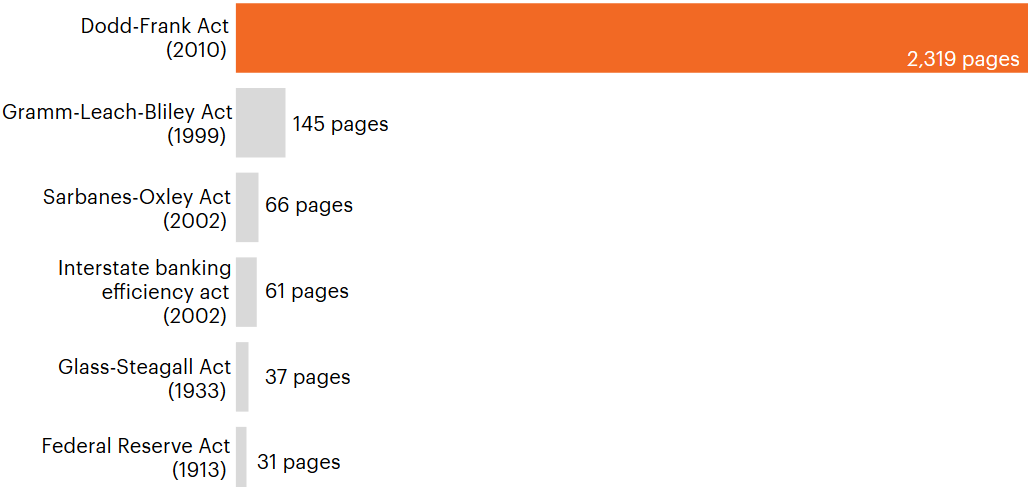Over the past several years, industry consolidation and the impact of increased banking regulations like Dodd-Frank have forced some commercial banks to reduce or eliminate businesses that lend to middle market companies. Firms have stepped in to help fill the lending void, or “be the bank” to these companies.
Recently, we have received many questions regarding the future of middle market lending amid rumblings that Dodd-Frank will be amended or repealed. Namely, what do we think is really going on, and what will the impact be on non-bank lenders?
Let’s start with a little history. Looking back on the financial crisis of 2008 – scratch that, let’s go back to 1929. The U.S. stock market had been on a tear throughout the 1920s with rampant speculation and margin leveraging. By the end of that decade, the economy had begun to decline and unemployment rose, leaving wildly excessive valuations that were divorced from fundamentals. The bubble burst in 1929 in a full-on panic, after which billions of dollars were lost, bankrupting thousands of investors. The Great Depression ensued and with it came regulation intended to protect investors and prevent another such disaster in the future – Glass-Steagall, the Securities Act of 1933, the Securities Exchange Act of 1934, the Investment Company Act of 1940 and the Investment Advisers Act of 1940. The regulatory process from start to finish took over 10 years to enact and implement. With the exception of the passage of the Gramm-Leach-Bliley Act in 1999, which repealed parts of Glass-Steagall and permitted the consolidation of commercial banks, investment banks, securities firms and insurance companies under a single entity, most of these regulations remain in place today.
Now let’s fast forward to 2008. There’s rampant speculation and leveraging at both the banking and household levels, panic hits, the bubble bursts, crisis results – wash, rinse, repeat. The aftereffect? More regulations. This time they were heavily focused on the concentration of risk at the largest institutions and on the concept of banks being “too big to fail.” Dodd-Frank was a massive piece of financial reform legislation designed to protect consumers by subjecting banks to much stricter oversight. The Volcker Rule restricted banks from making more speculative investments using their own balance sheet and limited bank investments in the private funds they manage. These regulations also categorized larger financial institutions as SIFIs or “systemically important financial institutions” that would be subjected to stress tests and mandated to meet stricter capital requirements.
A lending void
Regulations are typically put in place for the right reason – to protect people and the system in general. The issues with regulation usually relate to unintended consequences. And with Dodd-Frank and other regulatory requirements, such as the implementation of the Basel II capital standards, those consequences were felt. Because of these new limitations banks began to withdraw from the mortgage market, making it more difficult for consumers to obtain loans to purchase new homes. Small and mid-sized private businesses had increased difficulty obtaining credit to grow their companies. The consolidation of the banking system, which had begun in the 1990s, accelerated out of necessity for scale and survival – more than 1,700 small and community banks (nearly a quarter of the industry) were forced to merge or shut down. As a result, the “too big to fail” banks became even bigger. The Big 4 banks in the U.S. now control about 45% of total banking assets.
Non-bank lenders, which are not subject to traditional banking regulation, stepped in to fill the void and rapidly picked up market share. This void gave birth to new companies and led to the expansion of the lending platforms for many existing lenders and institutional investors to meet the needs of private companies and consumers (home, auto and student loans). While there has been a buzz about scaling back regulation, such an undertaking can be a tall order due to Dodd-Frank’s complexity.
Comparing Dodd-Frank with its bank regulatory predecessors

Looking ahead at regulatory reform
While the Dodd-Frank Act has many components, the reforms most relevant to non-bank lenders are those that would grant some relief to small community banks and SIFIs – those banks with over $50B in assets. In the ecosystem of lending, these two categories of firms sit on opposite sides of the capital spectrum, with non-bank lenders serving the “middle market” in between:
- Local community banks: Serve smaller, geographically concentrated private businesses typically with loans up to $2M (loans above that are too large for 80% of U.S. banks)
- The large “money center” banks like J.P. Morgan and Wells Fargo: Serve large national and multi-national corporations usually with very large syndicated loans ($500M into the billions)
- Non-bank private company lenders: Serve private businesses with loans, on the low end, of $25M–$50M and, on the upper end, of $100M–$300M+
Local community banks have suffered the most under Dodd-Frank, which has rendered small business loan growth anemic. They have seen their lending market share drop from 77% in 2000 to 43%.¹ The cost of compliance for these banks has skyrocketed, despite the fact that they are too small to be systemically risky. Revising regulations that hinder these small community banks would be a positive for small loan growth and mortgage availability to individuals. This appears to be a popular bipartisan issue and is likely passable.
On the other end of the spectrum, the biggest banks have grown so large that they will continue to face high regulatory scrutiny due to their disproportionate makeup in the U.S. banking system. Many of them have already devoted significant time, money and staffing to implement and adjust to much of Dodd-Frank. They would prefer specific accommodations on the regulations over a wholesale repeal of the law. While they will seek to ease some of the more stringent requirements on capital retention and risk-taking, they will continue to focus their attention on large capital market transactions.
In reality, a full-blown repeal of Dodd-Frank is very unlikely. Providing capital to private middle market companies, real estate transactions, energy infrastructure projects and the like will continue to be a role dominated by non-bank lenders that have proliferated over the past decade. Dodd-Frank may look a little different over the coming years, but we expect investors will continue to have the opportunity to “be the bank.”




